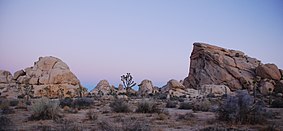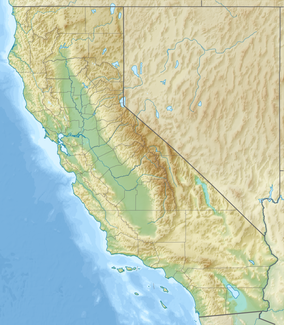Joshua Tree National Park
| Joshua Tree National Park | |
|---|---|
|
IUCN category II (national park)
|
|

Joshua Tree National Park: Cyclops and Pee Wee Formations near Hidden Valley Campground at sunrise.
|
|
| Location | Riverside County and San Bernardino County, California, United States |
| Nearest city | Yucca Valley, San Bernardino |
| Coordinates | 33°47′18″N 115°53′54″W / 33.7883944°N 115.8982222°WCoordinates: 33°47′18″N 115°53′54″W / 33.7883944°N 115.8982222°W |
| Area | 790,636 acres (319,959 ha) |
| Established | 31 October 1994 |
| Visitors | 2,505,286 (in 2016) |
| Governing body | National Park Service |
| Website | Joshua Tree National Park |
Joshua Tree National Park is located in southeastern California. Declared a U.S. National Park in 1994 when the U.S. Congress passed the California Desert Protection Act (Public Law 103-433), it had previously been a U.S. National Monument since 1936. It is named for the Joshua trees (Yucca brevifolia) native to the park. It covers a land area of 790,636 acres (1,235.37 sq mi; 3,199.59 km2)—an area slightly larger than the state of Rhode Island. A large part of the park, some 429,690 acres (173,890 ha), is a designated wilderness area. Straddling the San Bernardino County/Riverside County border, the park includes parts of two deserts, each an ecosystem whose characteristics are determined primarily by elevation: the higher Mojave Desert and lower Colorado Desert. The Little San Bernardino Mountains run through the southwest edge of the park.
The park was initially created as a National Monument on August 10, 1936, containing 825,000 acres (334,000 ha), after Minerva Hoyt led activism aimed at persuading the state and federal governments at protecting the area. In 1950, the size of the park was reduced by about 265,000 acres to exclude some mining property. The park was elevated to a National Park on 31 October 1994 by the Desert Protection Act, which also added 234,000 acres to the park.
The higher and cooler Mojave Desert is the special habitat of Yucca brevifolia, the Joshua tree for which the park is named. It occurs in patterns from dense forests to distantly spaced specimens. In addition to Joshua tree forests, the western part of the park includes some of the most interesting geologic displays found in California's deserts. The dominant geologic features of this landscape are hills of bare rock, usually broken up into loose boulders. These hills are popular amongst rock climbing and scrambling enthusiasts. The flatland between these hills is sparsely forested with Joshua trees. Together with the boulder piles and , the trees make the landscape otherworldly. Temperatures are most comfortable in the spring and fall, with an average high/low of 85 and 50 °F (29 and 10 °C) respectively. Winter brings cooler days, around 60 °F (16 °C), and freezing nights. It occasionally snows at higher elevations. Summers are hot, over 100 °F (38 °C) during the day and not cooling much below 75 °F (24 °C) until the early hours of the morning.
...
Wikipedia


